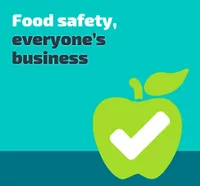World Food Safety Day: June 7, 2019

June 7, 2019, will be the first-ever observance of World Food Safety Day. This year, the theme will be “Food safety, everyone’s business.”
The adoption of World Food Safety is a joint venture between the United Nations (UN) General Assembly, the World Health Organization (WHO), and the Food and Agriculture Organization (FAO) of the United Nations.
WHO statement on World Food Safety Day:
Access to sufficient amounts of safe and nutritious food is key to sustaining life and promoting good health. Foodborne diseases impede socioeconomic development by straining health care systems and harming national economies, tourism, and trade. With an estimated 600 million cases of foodborne diseases annually, almost 1 in 10 people in the world fall ill after eating contaminated food. Food safety is an increasing threat to human health. Children under 5 years of age carry 40 percent of the foodborne disease burden with 125,000 deaths every year.
Food safety is key to achieving several UN Sustainable Development Goals and is a shared responsibility between governments, producers, and consumers. Everybody has a role to play from farm to table to ensure the food we consume is safe and will not cause damage to our health. Through World Food Safety Day, WHO pursues its efforts to mainstream food safety in the public agenda and reduce the burden of foodborne diseases globally.
FAO statement on World Food Safety Day:
United Nations statement on World Food Safety Day:
Food safety is key to achieving several of the Sustainable Development Goals and World Food Safety Day brings it into the spotlight to help prevent, detect, and manage foodborne risks. Safe food contributes to economic prosperity, boosting agriculture, market access, tourism, and sustainable development.
Goal 2 — There is no food security without food safety. Ending hunger is about all people having access to safe, nutritious and sufficient food all year round.
Goal 3 — Food safety has a direct impact on people’s health and nutritional intake. Foodborne diseases are preventable.
Goal 12 — When countries strengthen their regulatory, scientific, and technological capacities to ensure that food is safe and of the expected quality throughout the food chain, they move towards more sustainable patterns of food production and consumption.
Goal 17 — A globalized world with annual food exports currently in excess of USD 1.6 trillion and complex food systems demands international cooperation across sectors to ensure food is safe. Food safety is a shared responsibility among governments, food industries, producers, and consumers.
Keeping food safe is a complex process that starts on the farm and ends with the consumer. All stages of the food chain, from production, harvest and storage to preparation and consumption, must be considered. The FAO is the only international organization overseeing food safety along all aspects of the food chain.
Through a longstanding partnership, FAO and WHO support global food safety and protect consumers’ health. FAO generally addresses food safety issues along the food chain during production and processing, while WHO typically oversees relationships with the public health sector. Safeguarding food so that it is safe to eat doesn’t stop with its purchase though. At home, consumers have a part to play in making sure that what they eat remains safe.
Cognizant of the urgent need to raise awareness at all levels and to promote and facilitate actions for global food safety, the General Assembly decided to designate 7 June as World Food Safety Day.
Be sure to check out these World Food Safety Day resources provided by WHO, FAO, and UN. If you plan to observe, don't forget to use #WorldFoodSafetyDay on all social channels to share your efforts with us!
Looking for quick answers on food safety topics?
Try Ask FSM, our new smart AI search tool.
Ask FSM →








